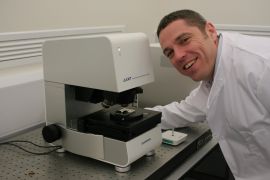Jul 6 2010
Olympus has today announced that the National Physical Laboratory (NPL) is using its LEXT OLS4000 in a project to establish good practice guidelines for the calibration of 3D/areal surface texture measuring instruments.
The NPL project will establish robust and easy to use calibration steps and reference standards for all the major areal surface measurement instrumentation technologies, with the LEXT chosen as the reference imaging confocal microscope. The good practice guide on calibration of confocal microscopes will also provide input to the upcoming ISO 25187-707 standard.
 Olympus LEXT NPL feat. Prof Richard Leach
Olympus LEXT NPL feat. Prof Richard Leach
Instruments capable of providing areal surface texture information, such as the Olympus LEXT OLS4000 confocal microscope, are becoming increasingly popular, but currently lack any traceability routes. As a result, ISO standards are being prepared by a team led by Prof Richard Leach, Principal Research Scientist at the NPL. As an important component of these standards, Prof Leach’s team is defining good practice guidelines using archetypal examples of: stylus instruments; white light interferometers; focus variation instruments; and confocal microscopes. The project will use a range of artefacts to characterise the scaling, linearity, orthogonality, angular response, repeatability and resolution of the X, Y and Z axes. The LEXT OLS4000 is being used by Prof Leach’s team as the archetypical confocal instrument, although the guide will not be specific to the Olympus instrument.
Prof Leach commented, “All measurement techniques require comprehensive reference standards to ensure consistency across the various instruments and technologies. These standards must also include robust, yet easy-to-use, calibration steps for each technology and, therefore, it is essential to have access to typical examples of each technology.” As well as enabling the generation of good practice guides, the project will also define the reference areal artefacts to be used during calibration. Once the project is complete, users of areal surface measurement instruments will be able to obtain a calibration ‘bento’ box with the guidelines and artefacts to ensure better accuracy both within and between instruments and projects.
Source: http://www.olympus-global.com/en/